Oleg Lugovoy
Dec 11, 2015
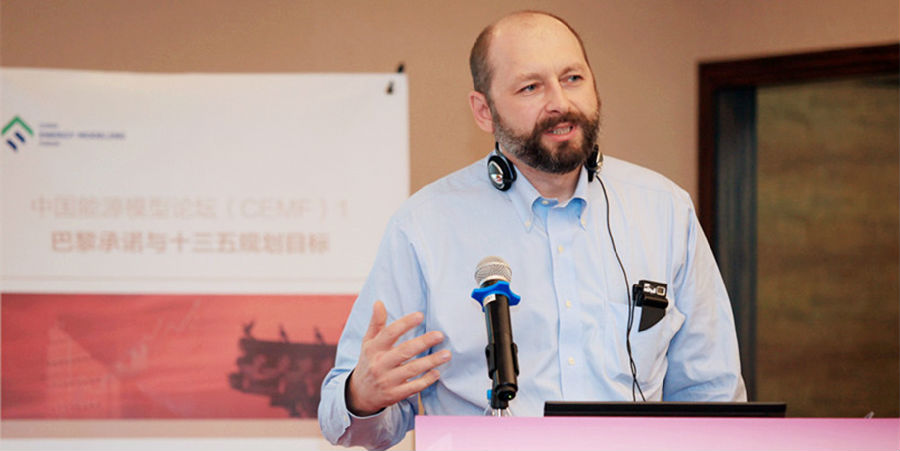
Dr. Oleg Lugovoy delivered a speech
Good afternoon, everyone. Thank you very much for introducing me just now, Madam Chair. I am very honored to be able to participate in today's meeting. It is very good to share my experience with you.
1. Introduction and classification of energy models
This is an outline of mine. Currently, available model categories include top-down, bottom-up, and hybrid models and the challenges the model faces. In addition, I will talk about the comprehensive evaluation system and CEMF's opportunities and challenges faced.
Now let’s talk about what a model is. The model we are talking about is actually a simplification and abstraction of the real world from the model we are trying to understand. In the process, we try to express it in a formula way. The second reason why we use the model is to use the model to make a rational decision, which is the fundamental purpose. For example, for some complex problems, you can use the model to make rational decisions, and you can use the model to perform quantitative simulations and evaluations. In addition, you can use this simulation to understand some internal processes. In addition, you can learn how to use this model Some of the content is reflected to solve some problems encountered in our real-life work.
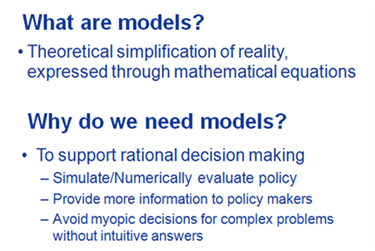
What is an energy model? Why do you need a model?
This is a situation of the model we have seen, so in fact, there are not many ways of modeling. Of course, there are many specific models, but the model can be divided into two directions, one is top-down, and the other is bottom-down superior. Of course, according to different energy types, there are different models in China and abroad, so let's look at the top-down, bottom-up, and mixed models.
Let's take a look at what the bottom-up models have. Since we say bottom-up, it makes technology selection easier. Generally, these models use linear programming methods. There are some very famous models such as Here is a list of some very famous models for you, and we are now launching some new models.
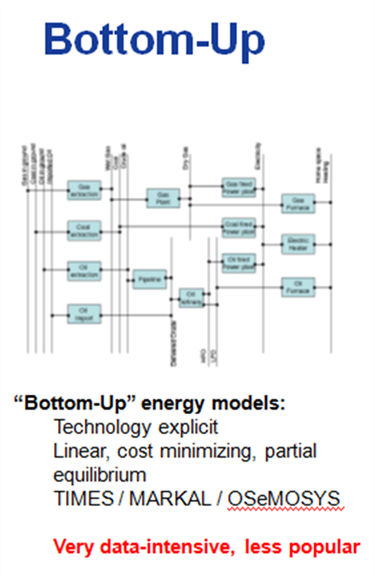
Bottom-up model
The second type is the top-down model, which is a model for us to describe the economic method in a more detailed manner. In addition, it can better show the operation of the economic system, so once we have a very large and complex model, such as when it comes to expressing economic behavior, the model should be simplified. The picture shows the CGE model in the top-down model.

Top-down model
In addition, I talked about the mixed model. The top-down and bottom-up models are to some extent the sum of connections, which is the third type of mixed model. Now I should say that it is a very important direction, so We have now fully realized that we need to integrate different models together, so we will introduce this hybrid model later.
Let's look at the bottom-up and top-down models for some comparisons. The bottom-up energy model is more about describing the details of technology, while the top-down economic model covers the entire economic system. In general, we say that the top-down model can calculate the general equilibrium model. For example, some details of the economy can be reflected in this way. Each region has its own unique model. For example, some details of an economy are different, but the main idea of the top-down model is to have a general equilibrium model, this way to reflect the input-output balance of capitalization value. Top-down is a system that talks about many technologies, such as the production and processing of natural gas, and some products may be metals, heating, construction, etc., so the main consideration is to use such a model. The bottom-up model is based on technology, and there is not much other content in it, so I want to simplify what I just said here. Let's take a look at the bottom-up technology model. Here we have every process from energy production to final use. If our resource is coal, the process is the process of using coal, such as the combustion process. In this process, emissions are produced, and this process also requires some technology, and the final product that may be produced is electricity, so this is a display of a very simplified model. So we have coal and the technology, which is the combustion process. In this process, of course, there are some very specific technologies, We end up with these products and by-products.
2. Domains and Problems of Several Model Types
So let's take a look at the top-down typical fields and typical problems. We hope to use this model to analyze the overall economic impact or the overall impact of a certain economic policy. Influence, here we talk about welfare, GDP loss or increase. In addition, we also discuss industrial structure, economic structure and international trade. For example, there are some specific examples. Some policies may have a very good impact on the overall economy. The overall economic impact is not particularly good. Here I want to say that the best or best way to use this model is the short-term impact of taxation, trade, and tariff policies.
Let's take a look at the top-down field. It is also supported by technology. We also consider measuring its results and calculating its emission reduction potential. We can also make some models like this. It can simulate some emissions, their increase and decrease, to measure some related parameters, and use the language of the model to help us share some policies including taxes, quotas, subsidies, etc., to simplify our economy, see economic resilience, the results of this simulation show that sometimes there is a policy shock, we call it a policy shock, and there is also a balance. This is our simulated policy, which is a simulation in a bottom-up technical model. From resources to combustion to electricity, here I would like to introduce that in such a case, we have such a model, which can have such a balance, and this balance model allows us to deal with it. We need such technologies to deal with, for example, the capital it emits, which can measure how much you invest in each stage. What kind of model should we use? Different models are applied to different cases. Therefore, when we talk about the environment, environmental policies, and possible technological changes caused by policies, etc., there will be different applications. At the same time, we will also consider our energy policy, this does bring us some problems. The static impact of changes in energy policy on the research scope, if we have such a limitation, apply to the local economy, or need external whether it is necessary to take into account the relationship between investment in the energy sector and economic growth, and other aspects, we have such models that are bottom-up, which means that when we make investment decisions when and where to invest, we have traditional energy and new energy, which of these two aspects will benefit us more, does it have such positive impacts and returns in the future, if we do not consider In the future, such a model is not a successful model.
Next I will say why the bottom-up model is not enough.
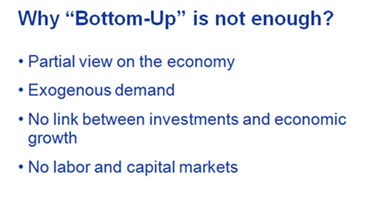
Because sometimes, we have to deal with an energy problem, but we don’t know how to deal with the entire economic system. We may mean that such a change in demand has not been established. This must take into account the relationship between energy investment and economic growth. Therefore, when we invest, especially when considering the future, this model can help us measure some facts, such as its economic growth and our investment in green development. Some models can help us make decisions in investment. For example, if we consider an increase in GDP, we have such consumption, we have such investment, and investment is also a part of GDP. We need to have such relevant knowledge. In the future, In terms of energy, we can make a correct decision. We will also consider what kind of return this model will bring us. Many of these models will take into account factor markets such as labor and capital. Let’s look at this model's structure below, which is also very important.
First of all, we have EM25, which has different models and some mixed models, which can also bring us different results. First of all, this model is a bottom-up technical model, and its analysis results make top-down The results of the model analysis are more diverse, and the results it brings are completely different, so now we link the bottom-up and top-down models and build a mixed model has become a consensus.
3. Introduction to the Mixed Model
How to build a hybrid model modeling. First of all, we usually say that we want to simplify the model, but when it comes to this hybrid modeling, there must be such a strategy, from its consumption framework, after establishing such a conceptual framework. From different levels, such as technical details, technical changes, including some cost considerations at different levels, and the complexity of its operation and calculation, we need to take its linear optimization and nonlinear optimization into account when modeling the combination of optimization can reduce the difference, because its user interface is different, so it cannot be integrated and optimized.
We have several different hybrid modeling methods. First of all, the first one is a top-down integration connection between the technical model and the economic model. You need to reuse some of its model characteristics and reduce the dimensionality. To do some other optimizations, the other method is called soft connection. In the integration, the result of one model is used as the input of another model. For example, its demand can be used to put it into another simulated economic balance model. There will be enough technical information, or synergy, to make a synergistic model among them. In the process of one model and another model, such a method requires a synergistic connection, that is to say, use one model to estimate or It is said to calibrate the parameters of another model to ensure that the inputs of the two models are consistent. There are two models, one of which represents a part of the other model. For example, the energy model represents a part of another large model. It is necessary to calibrate it, simplify some of its functions, and make collaboration in the whole process.
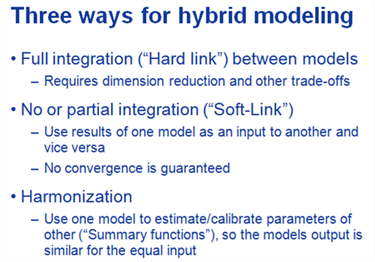
Different Mixture Model Types
Here is an example, this is a top-down energy system, and this is the function of ETSA. We see this energy analysis, all-natural gas, coal, and oil, which have a mixed function. There is such an energy type, its flexibility is different from each domestic sector, and then we try to use the bottom-up calculation to embed its production function to determine the parameters of its production function it uses. Based on the analysis results of the bottom-up technology model, for example, if you have some terminal needs, you need to embed the production function of CES, which is not a simple embedding.
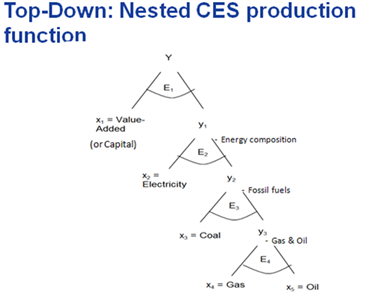
Embedding other technologies in the top-down model
In the usage model, overall productivity needs to be considered. Other exogenous technologies may substitute embedded end needs. When using the production function, these alternative techniques need to be considered. Take the graph as an example, where x1 and x2 are an alternative.
We have fuel 1 and fuel 2, which are two fuels of energy. We see that its functions include production functions, including a scenario by 2020 and 2030. Here is the situation in 2010, so we can make some changes to it. But if you look at the situation in 2020, some changes can be made here, such as some adjustments to the energy structure, and the cost will also change at this time.

Endogenous technology change: Of course, by 2030, we can see that there are 20 years from 2010, so many different production capacities can be produced in 20 years, that is, there are many in all aspects chance, so from this point of view, we can change the parameters of a situation. So there can be a lot of variables in 20 years, and it can work in such a way, so we tried to reconstruct such a result, and we found that the model is actually very simple, but how to use technology to achieve the results of the model should be said to be more important than the discussion of the model.
So here is another example for everyone. Now let’s assume that we have an alternative solution between gas and coal, so we now assume that there is a new investment, and we have made new investments from now to 2030. During this process, energy efficiency has also been improved, so there has been an increase in energy efficiency, but the products we produce are the same. So in this process, you will see this shape of the curve, the consumption of coal and gas. However, if we have more coal technology, we will find that this curve will shift to a certain extent, so it will move from the original solid line curve to the current dotted line curve. This process reflects the change in our energy structure, so we can also consider using a mixed model from here because the impact on the overall economy must be considered when technology changes. At this time, an additional curve or additional curve may appear. A point so that research can be done here.
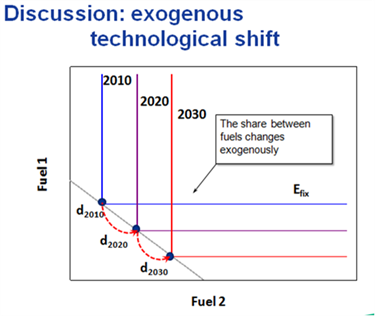
Exogenous technological change
Okay, we found that the hybrid model is better than the bottom-up and top-down models through the way we just said, but the hybrid model is not perfect, not enough. Why?

Because non-economic variables and indicators cannot be covered, for example, we have a very good model, which fully reflects the parameters of energy and economic parameters, but for other dimensions, such as ecological balance and human health, these are very important factors in our mixed model, but it is not covered, especially in China, we found that China has a lot of non-economic growth, such as the improvement of the environment, so we have no way to cover these factors in the model, so in this case, we need to expand our model further and carry out interdisciplinary comprehensive evaluation expansion. For example, energy, economy, atmosphere, water, land, human health, etc., will be integrated into this process. What we show you here is what our future direction should look like. For all modeling people, these factors should be considered, and all these related factors mentioned just now should be integrated to provide better support for decision-making.
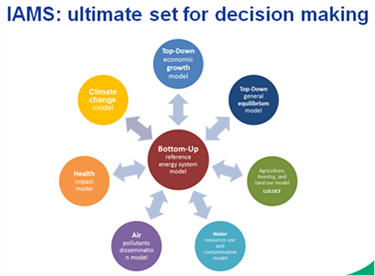
Comprehensive form
There is a top-down model in the middle and a top-down model. We use the top-down model to balance changes in the economy, and then we need to balance the existing investment and economic effects. In connection, agriculture and forestry are also very important parts, so if we only look at one direction, this part will consider this direction. In addition to this, there are atmosphere, water, land, and human health, so we are doing In the decision-making process, these different models need to be combined, because only by combining the whole can we create an interdisciplinary comprehensive evaluation system, which is also a mainstream direction in the future.
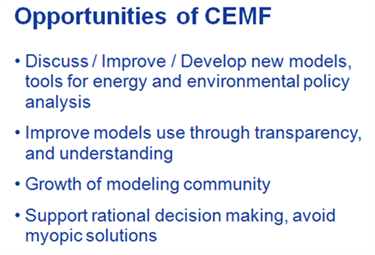
4. About China Energy Modeling Forum (CEMF)
CEMF Development Opportunities
Finally, I would like to tell you about the development opportunities of the China Energy Forum Model. It should be said that this is a very good platform. Through discussions, everyone can learn more about new platforms, and can improve our current modeling tools to provide strong support for economic and environmental policy analysis. I think this is a very good communication platform, which can better promote the transparency of modeling, let everyone find a better sense of belonging, and analyze and communicate more with each other. Today we found that, for example, some economic dimensions are very important to the decision-making process. What I want to talk about is these contents. Thank you very much for listening. Thank you.

